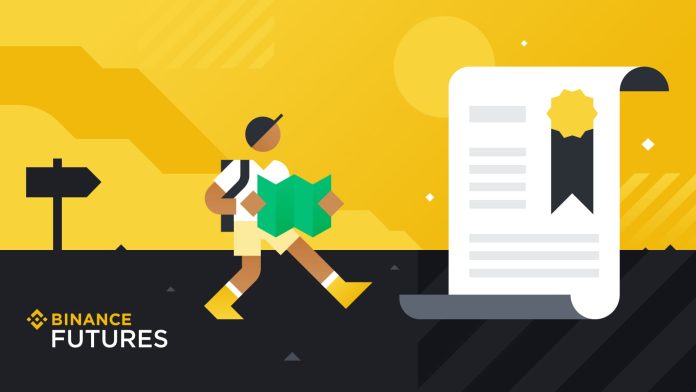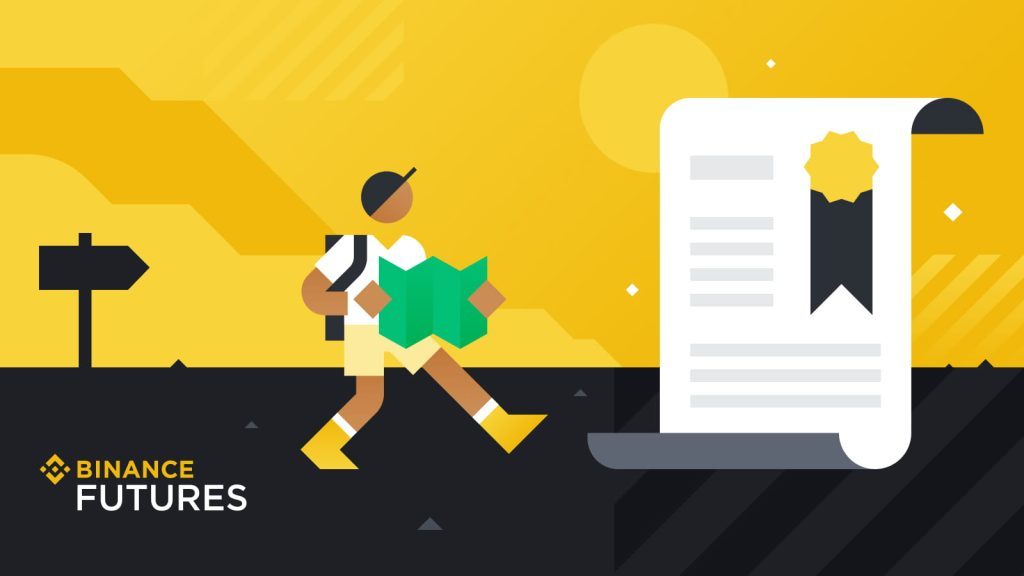
Welcome to our comprehensive guide to crypto futures trading on Binance Futures, one of the leading cryptocurrency exchanges in the world. This blog post will provide a detailed overview of Binance Futures, how it works, and why it has become a popular platform for traders interested in futures trading. Whether you are new to the concept of futures trading or an experienced trader looking for a reliable platform, this guide will equip you with all the information you need to get started on Binance Futures.
1. What is Binance Futures?
Binance Futures is a derivative product offered by Binance, one of the largest and most reputable cryptocurrency exchanges globally. It allows traders to speculate on the price movements of various cryptocurrencies without actually owning them. Essentially, futures contracts enable traders to agree to buy or sell an asset at a predetermined price at a future date.
With Binance Futures, users can trade perpetual and traditional futures contracts with up to 125x leverage. Perpetual contracts have no expiry date and mimic spot trading with added leverage options. On the other hand, standard futures contracts expire at a specified date and time. The availability of both types of arrangements offers flexibility and caters to different trading strategies.
2. Benefits of Trading Crypto Futures on Binance
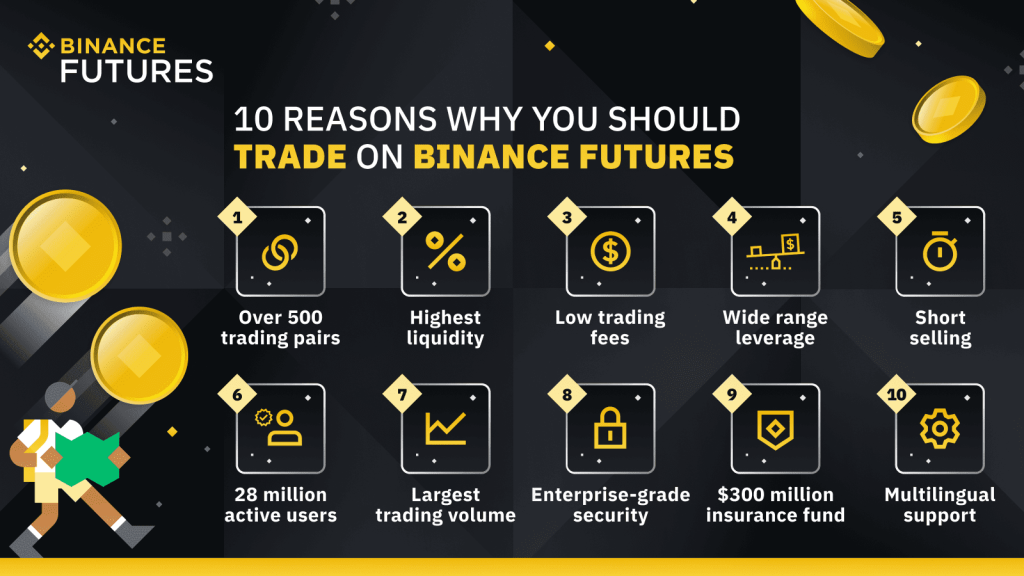
Liquidity:
Binance, the renowned cryptocurrency exchange platform, has built a solid reputation for its exceptional liquidity across multiple markets, especially when it comes to crypto futures. This noteworthy feature allows traders to effortlessly enter and exit positions without encountering any substantial issues related to slippage or market impact. Thanks to Binance’s impressive liquidity, traders can enjoy smooth and seamless transactions while maximizing their trading potential.
Leverage Options:
Binance Futures, a reputable trading platform, provides traders with an enticing opportunity to maximize their returns by utilizing leverage. By utilizing leverage, traders have the ability to exert control over larger positions in the market while only needing a fraction of the total capital required. Nonetheless, it is crucial to bear in mind that while leverage has the potential to magnify profits and yield substantial gains, it also simultaneously heightens the risk of incurring losses. Therefore, caution and careful risk management strategies must be implemented when engaging in leveraged trading on Binance Futures.
Diverse Range of Tradable Assets:
Binance Futures provides an extensive selection of cryptocurrencies for trading. From popular assets like Bitcoin (BTC) and Ethereum (ETH) to altcoins, users have access to a wide range of tradable assets, allowing them to diversify their portfolios and take advantage of various market opportunities.
Advanced Trading Tools:
Binance Futures offers advanced trading tools and features to enhance traders’ experience. These include charting tools, order types, position management options, and risk management tools. Traders can also set up stop-loss orders and take-profit orders to manage their positions effectively.
How Do Crypto Futures Work?
While digital assets are met with diverse and unique challenges, from high volatility to negative publicity, some traders use this volatility to their advantage.
The most vital thing to note in crypto futures trading is that you only take risks on the price changes without holding the actual cryptocurrency.
Let’s consider a simplified example!
John entered a long futures position when BTC traded at $40,000, while Sarah entered a short position simultaneously. Then, prices moved up, and John and Sarah decided to settle their positions at $45,000. In this case, holding a losing trade, Sarah will have to pay the exchange the deficit loss of $5,000 ($45,000-$40,000 = $5,000). John, on the other hand, will receive a profit of $5,000 from the exchange.
Basic Concepts of Crypto Futures Trading
Traders tend to familiarize themselves with the essential concepts that are involved in crypto derivatives to have a better understanding of the benefits these financial products have to offer.
Here are a few terminologies that can get you closer to becoming a successful crypto derivatives trader.
Leverage
- The availability of leverage in the futures market is a compelling factor that attracts traders, as it offers significant capital efficiency.
- To illustrate, if one were to purchase 1 BTC on the spot market, it would require a substantial investment worth thousands of dollars. However, in futures trading, one can open a long BTC position with only a fraction of the cost through the use of leverage.
- In contrast, spot trading does not provide the option for leverage. Consequently, if you have 100 BUSD in your spot wallet, you can only afford Bitcoin worth 100 BUSD without the ability to amplify your position through leverage…
Margin Requirements
- To initiate a futures position, an initial margin is required. This margin represents a percentage of the notional value of the futures position and serves as collateral, typically in BUSD or another accepted form, when utilizing a futures trading account.
- Conversely, the maintenance margin refers to the minimum balance that traders must maintain in order to keep their trading positions open. Continuous checks on the maintenance margin are conducted to calculate margin utilization.
- If a trader’s maintenance margin limit is reached, it triggers the liquidation of their open position(s). This mechanism helps protect against excessive losses by automatically closing positions that fall below the required maintenance margin threshold…
Funding Rates
- Unlike traditional futures contracts, crypto perpetual contracts do not have a settlement process. To maintain the convergence between index prices and futures prices, exchanges implement a mechanism known as the funding rate.
- The funding rate is determined by calculating the price disparity between spot and futures markets. Investors holding open positions will either pay or receive funding based on their market exposure, potentially impacting their trading outcomes.
- In certain situations, such as during an excessively bullish market, funding rates may experience a significant increase. This can increase costs for traders holding long positions, affecting their profitability and overall trading strategy…
Pros & Cons of Trading Futures
Lucrative endeavors such as futures trading come with their fair share of advantages and disadvantages. Herein are the pros and cons of trading these crypto derivatives.
Pros
- Cryptocurrency futures trading allows traders to speculate on market movements by taking positions that profit from upward and downward price trends. This flexibility enables traders to go long or short, depending on their market expectations.
- Leverage is pivotal in crypto futures trading, allowing traders to amplify their exposure to an asset with only a fraction of the total cost. This feature empowers traders to control larger positions and potentially magnify their profits.
- A significant advantage of futures trading is its utility as a hedge against spot markets. By utilizing futures contracts, traders can effectively manage risk and protect their investment portfolios in various market conditions, providing valuable diversification benefits…
Cons
- The high volatility in the cryptocurrency markets can be a blessing or a torment to traders because the direction of an asset is not guaranteed.
- The leverage exposure can lead to significant losses, especially for novice traders who do not implement a solid risk management strategy.
How to Open a Binance Futures Account
Before opening a Binance Futures account, you need a regular Binance account. If you don’t have one, you can go to Binance and click on Register in the top right corner of your screen. Then follow these steps:
- Enter your email address and create a safe password. If you have a referral ID, paste it into the referral ID box. Click [Create Account] to continue.
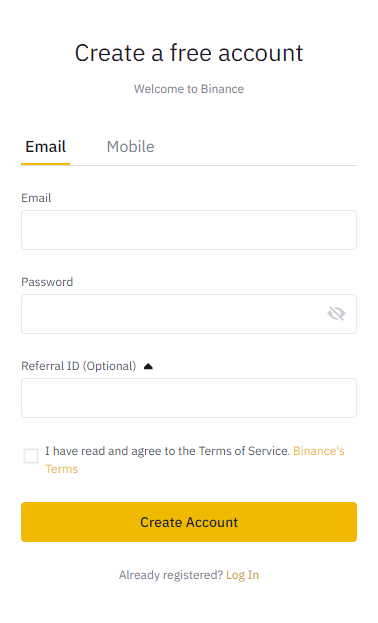
- You will receive a verification email shortly. Follow the instructions in the email to complete your registration.
- Next, log in to your Binance account, move your mouse to the bar at the top of the page on [Derivatives], and click USD(S)-M Futures.
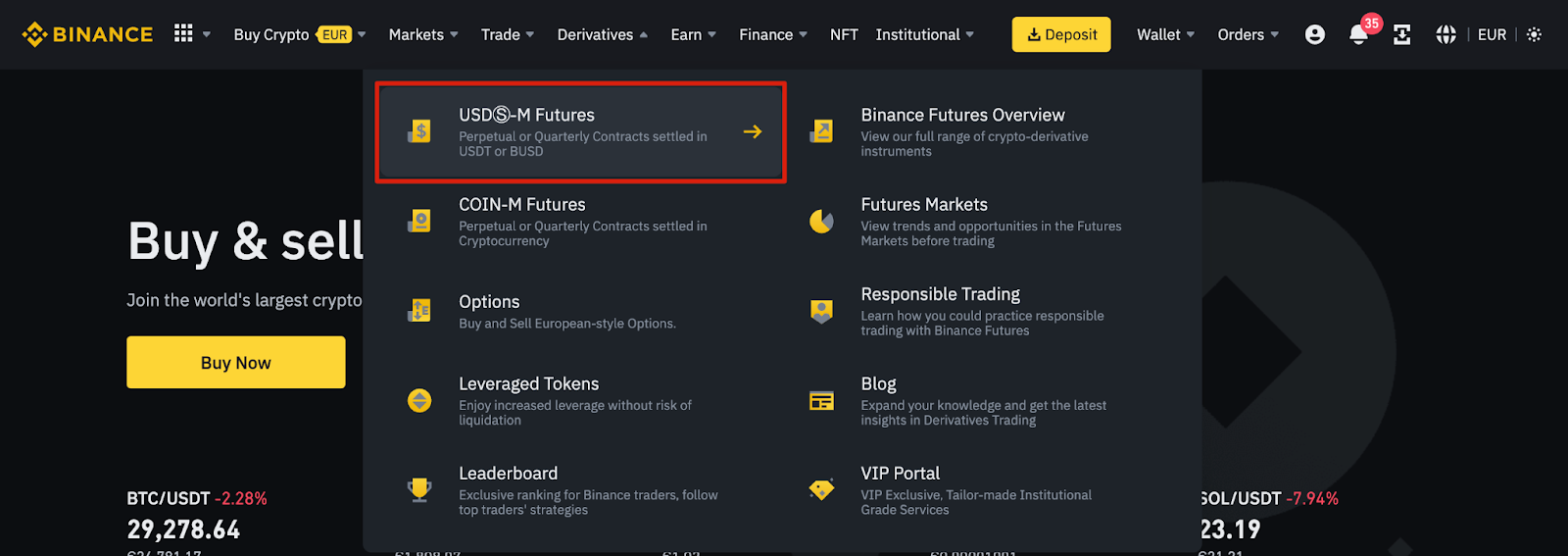
- Click the [Open now] button to activate your Binance Futures account. You’ll now be able to trade futures products on Binance. Note that you should still prepare and educate yourself before you can responsibly use the product.

If you’re new to trading futures, refer to the Binance Futures FAQ for an overview of the contract specifications on offer. If you’d like to test out the platform without risking real funds, you can also try out the Binance Futures testnet.
How to Fund Your Binance Futures Account
To fund your Futures account, you’ll first need to make sure you have funds available in your Binance account you can transfer over. These funds could be in your Funding, Fiat and Spot, Margin, or Options wallet. If you don’t have any funds deposited to Binance, we recommend reading our How to Deposit on Binance guide.
- To transfer funds to your Futures Wallet, click on the transfer icon on the right side of the Binance Futures page.
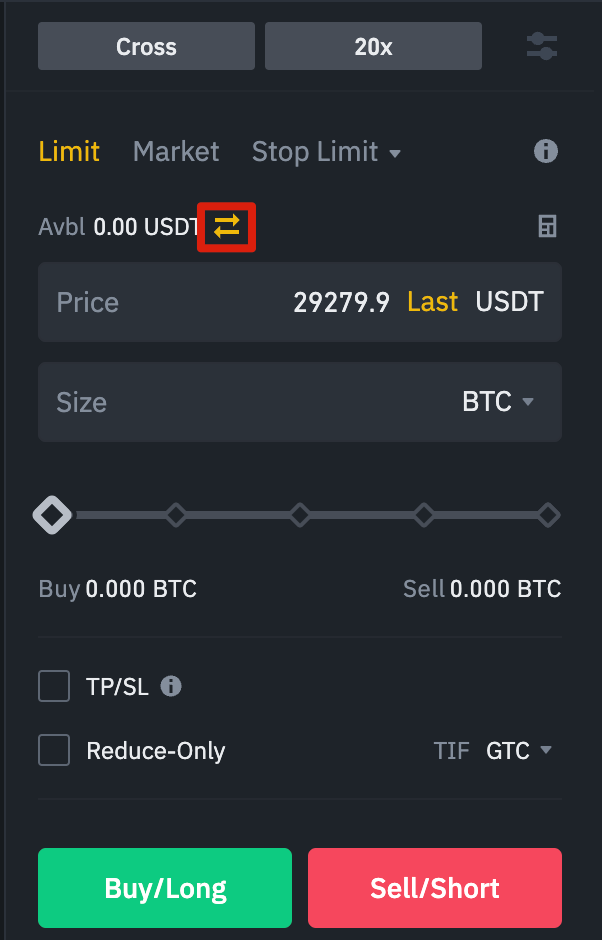
- Set the amount you’d like to transfer and the wallet you want to use before clicking [Confirm]. You should see the balance added to your Futures Wallet shortly. You can also change the direction of the transfer should you wish.
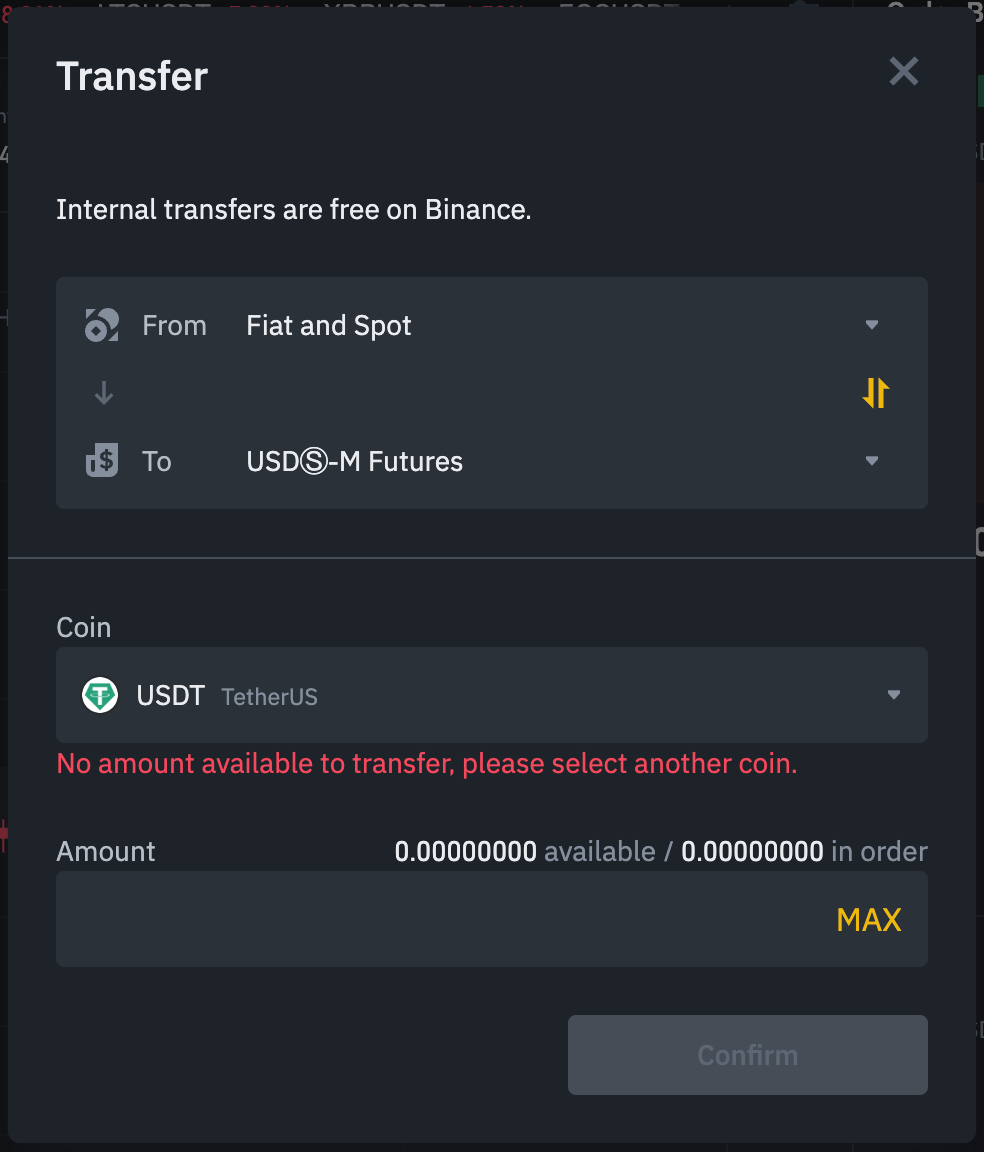
Understanding the Binance Futures Interface
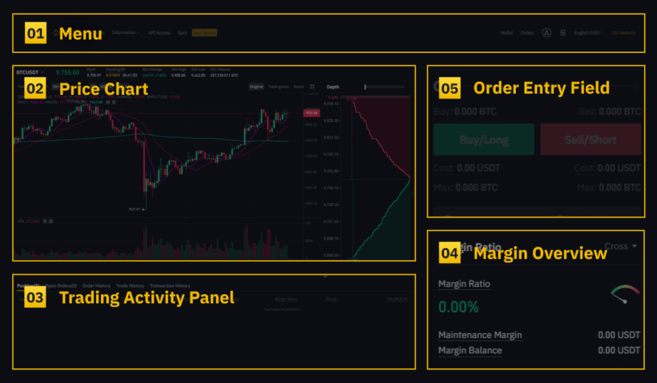
1. In the [Menu] area, you’ll find links to other Binance pages, such as COIN-M Futures, Options, Strategy Trading, and Activities. Under the [Information] tab, you can find links to Futures FAQ, API Access, funding rate, index price, and other market data.
You can access your Binance account on the top bar’s right side. You can easily check your wallet balances and orders across the entire Binance ecosystem.
2. In the [Price Chart] section, you can:
- To select a contract, hover over the name of the current contract, which is typically set as BTCUSDT by default.
- It is crucial to verify the Mark Price, as liquidations are triggered based on this specific price.
- Take note of the expected funding rate and observe the countdown indicating the time remaining until the next funding round.
- Access your current chart, with options to switch between the Original or integrated TradingView chart. This feature gives you a real-time visualization of the order book depth by selecting [Depth]…
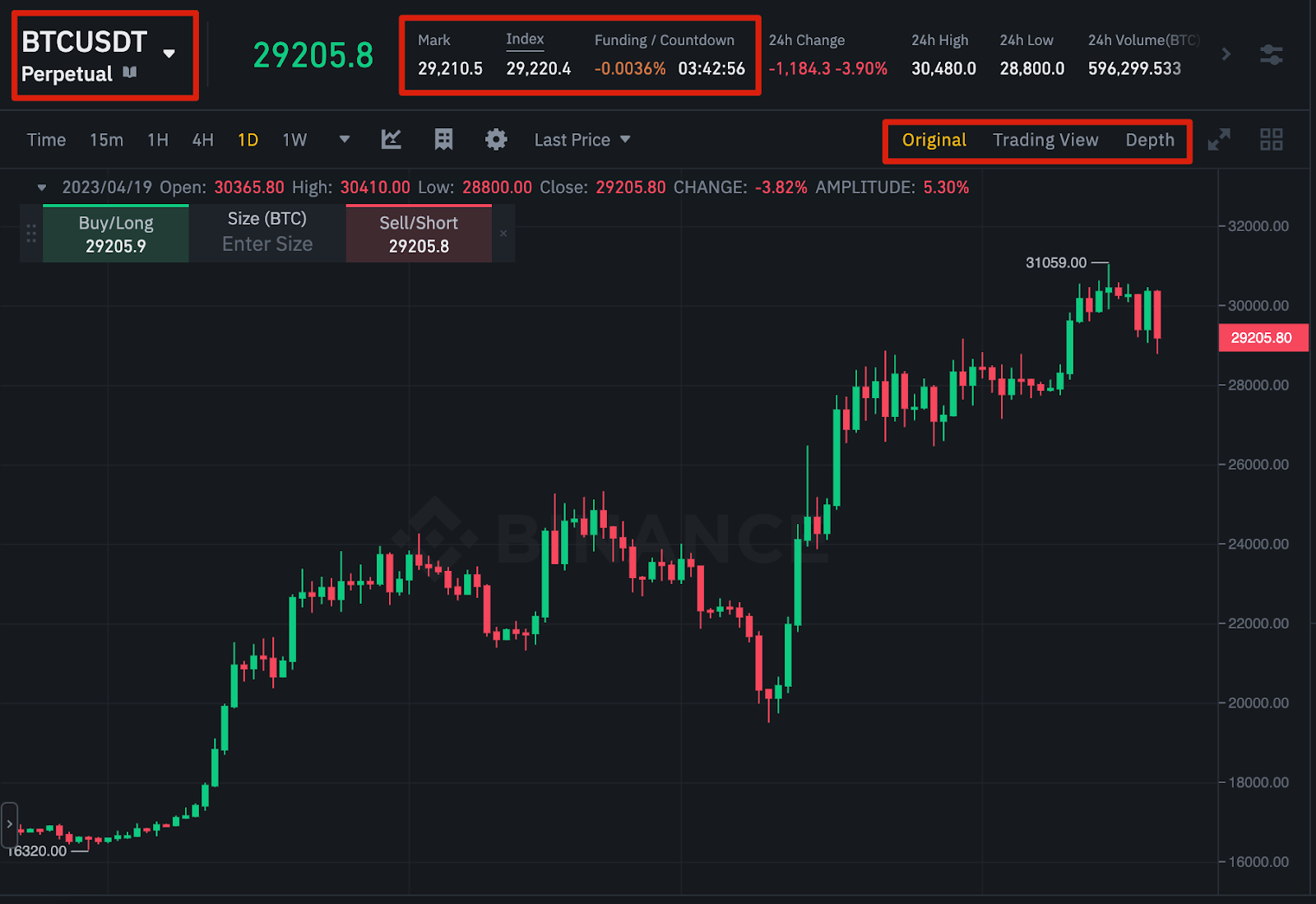
- See live order book data. You can adjust the accuracy of the order book in the dropdown menu in the top right corner of this area (0.01 by default).
- See a live feed of previously executed trades on the platform.
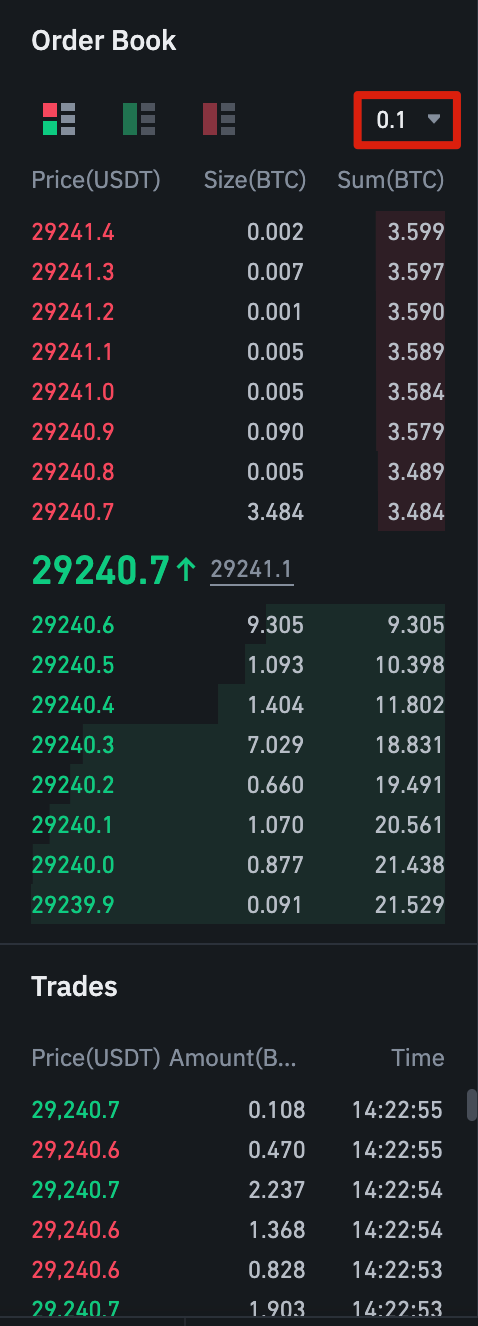
3. The [Trading Activity Panel] lets you monitor your futures trading activity. You can switch tabs to check your position’s current status and currently open and previously executed orders. You can also get a full trading and transaction history for a given period.
This section also allows you to monitor your position in the auto-deleverage queue under ADL. This is especially important to pay attention to during periods of high volatility.

4. In the [Margin Overview] section, you can check your available assets, transfer, and buy more crypto. This is also where you can view information relating to the current contract and your positions. Be sure to keep an eye on the margin ratio to prevent liquidations.
By clicking on [Transfer], you can transfer funds between your Futures Wallet and the rest of the Binance ecosystem.

5. The [Order Entry] field is where you’ll input your Buy/Long and Sell/Short orders. You can further find a detailed explanation of the available order types in this article. You can also switch between Cross Margin and Isolated Margin at the top of the view. If you want to adjust your leverage, click on your current amount (20x by default).

In all of these modules/sections, you can resize the element to your liking. Whenever you see an arrow on the bottom right corner of a module, you can drag it to your preferred layout. This way, you can easily create your custom interface.
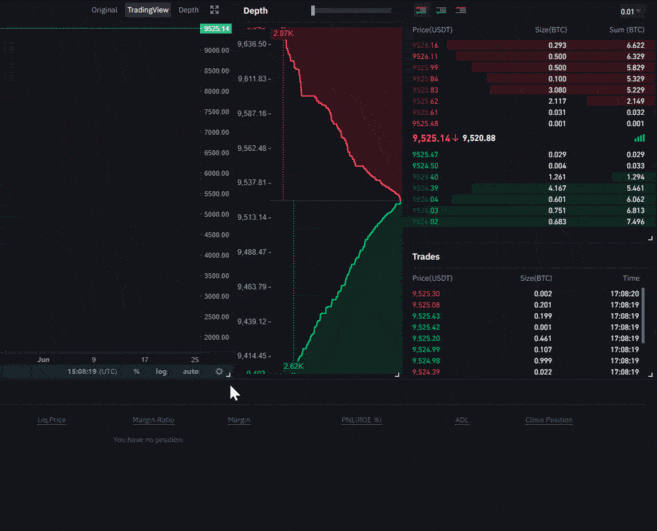
How to Adjust Your Leverage
Binance Futures allows you to adjust the leverage of each contract manually. To choose a specific contract, go to the top left of the page and hover over the current contract (BTCUSDT by default).

To adjust the leverage, go to the [Order Entry] section field and click on your current leverage amount (20x by default). You can specify the amount of leverage by adjusting the slider, typing it in, and clicking on [Confirm].

Note that the larger the position size, the smaller the leverage you can use. Similarly, the smaller the position size, the more leverage you can use. Using higher leverage also carries a higher risk of liquidation.
As always, every trader should carefully consider the leverage they use and its associated risk.
What Is the Difference Between the Mark Price and Last Price?
To avoid spikes and unnecessary liquidations during periods of high volatility, Binance Futures uses a last price and mark price.
- The last price is easy to understand. It means the last price the contract was traded at. In other words, the last trade in trading history defines the last price. It’s used for calculating your realized PnL (Profit and Loss).
- The marked price is designed to prevent price manipulation. It’s calculated using a combination of funding data and a basket of price data from multiple spot exchanges. Your liquidation prices and unrealized PnL are calculated based on the mark price.

Note that the mark price and the last price may differ.
Setting stop price triggers
When setting an order type that uses a stop price as a trigger, you can select either the last price or the mark price as the trigger. To do this, select the price you wish to use in the [Trigger] dropdown menu at the bottom of the order entry field.

What Order Types Are Available, and When to Use Them?
When placing your orders, you have a range of options to choose from:
Limit Order
A limit order is an order placed on the order book with a specific limit price. When you place a limit order, the trade will only be executed if the market price reaches your limit price (or better). You can potentially use limit orders to buy at a lower price or sell at a higher price than the current market price.
Market Order
A market order is an order to buy or sell at the best available current price. It is executed against the limit orders previously placed on the order book. You will pay fees as a market taker when placing a market order.
Stop-Limit Order
The easiest way to understand a stop-limit order is to break it down into its stop price and limit price. The stop price is the price that triggers the limit order, and the limit price is the limit price of the triggered limit order. This means that once your stop price has been reached, your limit order will be immediately placed on the order book.
Although the stop and limit prices can be the same, this is not a requirement. In fact, you could set the stop price (trigger price) a bit higher than the limit price for sell orders or a bit lower than the limit price for buy orders. This could increase the chances of your limit order filling after reaching the stop price.
Stop Market Order
Similar to a stop-limit order, a stop market order uses a stop price as a trigger. However, when the stop price is reached, it triggers a market order instead.
Take-Profit Limit Order
- A take-profit limit order shares similarities with a stop-limit order, as it entails a trigger and limit prices. The trigger price initiates the order, while the limit price determines the price at which the limit order is placed on the order book. However, it is important to note that a take-profit limit order specifically reduces open positions.
- Utilizing a take-profit limit order can prove advantageous in managing risk and securing profits at predetermined price levels. This order type can also be effectively combined with other orders, such as stop-limit orders, thereby enhancing control over your positions.
- It is worth mentioning that take-profit limit orders are distinct from OCO (One Cancels Other) orders. For instance, if your stop-limit order is triggered while you have an active take-profit limit order, the latter will remain active until manually canceled. To set a take-profit limit order, navigate to the [Stop Limit] option in the order entry field..
Take-Profit Market Order
Similar to a take-profit limit order, a take-profit market order uses a stop price as a trigger. However, when the stop price is reached, it triggers a market order instead. You can set a take-profit market order under the Stop Market option in the order entry field.
Trailing Stop Order
- Implementing a trailing stop order offers a valuable mechanism for securing profits while limiting potential losses associated with your open positions. In the case of a long position, the trailing stop will dynamically adjust upwards as the asset price rises.
- However, should the price experience a decline, the trailing stop will cease to move. A sell order will be automatically executed if the price moves in the opposite direction by a specified percentage (called the callback rate). The same principles apply to short positions, albeit in reverse. In this case, the trailing stop moves downwards in line with market movements but halts its adjustment if the market begins to rise. A buy order is triggered if the price moves by a predetermined percentage in the opposite direction.
- The activation price is the pivotal point that triggers the execution of the trailing stop order. Without specifying an activation price, it defaults to the current Last or the mark price. You have control over selecting which of these prices should serve as the triggering factor at the bottom of your order entry field.
- The callback rate determines the extent to which the trailing stop follows and trails behind changes in price. For example, setting a callback rate of 1% ensures that as long as your trade progresses favorably, the trailing stop will maintain its position at a distance equivalent to 1% from current levels. Conversely, should a movement exceed 1% against your trade’s direction, a buy or sell order (depending on your trade’s direction) will be promptly executed.
Four Tools to Trade Crypto Like a Pro on Binance Futures
Grid Trading
- Binance Futures has developed a user-friendly and highly effective strategic trading tool known as Grid Trading. This innovative feature facilitates the automatic execution of buy and sell orders within pre-set price ranges at predetermined intervals.
- The Grid Trading tool demonstrates exceptional efficacy in both volatile and stagnant market conditions, particularly when the price of a specific cryptocurrency fluctuates within predefined levels. Even in shorter time frames, this automated trading tool significantly enhances the likelihood of buying at lower prices and selling at higher prices.
- To illustrate its functionality, consider arithmetic or geometric Grid Trading strategies. In these cases, buy/long orders are automatically executed as BTCBUSD experiences a decline, while sell/short orders are placed at higher prices. Similarly, during a downward trend, sell/short orders are automatically executed as ETHBUSD surges, while buy/long orders are established at lower prices to capitalize on the resulting difference in value…

With Grid Trading, you don’t need to forecast the direction of the trend. All you need to do is determine a reasonable price range in a time frame to ensure that your strategy generates positive returns.
We provide a set of pre-built parameters to help beginners take advantage of Grid Trading. These parameters include lower price limit, upper price limit, and grid count. Go to Binance Futures’ Strategy Trading and try it now!
Time-Weighted Average Price (TWAP)
- Binance Futures proudly extends the Time-Weighted Average Price (TWAP) algorithmic trading execution tool to both regular and VIP users, exemplifying our commitment to providing comprehensive solutions. This sophisticated tool empowers traders to effectively divide a larger order into smaller ones and execute them at regular intervals automatically.
- One of the key advantages of implementing a TWAP strategy lies in its ability to mitigate market impact when the order size surpasses the available liquidity on the order book. Consequently, it endeavors to execute an order gradually over a predetermined duration, thereby ensuring that the average execution price aligns closely with the time-weighted average price during that particular period.
- To illustrate, consider a scenario where a trader intends to purchase 10,000 BNBBUSD Futures Contracts. By employing a TWAP strategy, this trader can attain optimal average execution prices while circumventing undue increases in asset value. Assuming 60 minutes and an order count of 20, there would be a three-minute interval between each buy/long order…

High-frequency traders tend to implement TWAP strategies because this algorithm allows them to distribute orders without having their positions known by other traders. Essentially, it enhances any trading strategy and simplifies the decision-making process.
The TWAP strategy trading algorithm is simple, and no coding is required to use this institutional-grade tool. Go to Binance Futures’ Strategy Trading and try it now!
Advanced TP/SL
- At Binance Futures, we recognize the paramount importance of risk management in pursuing success for every trader. Consequently, we have meticulously developed an Advanced Take-Profit and Stop-Loss feature that gives you precise control over every one of your trades.
- The Advanced TP/SL function can be regarded as an integral component of your comprehensive exit strategy for every trade executed. These orders are intelligently programmed to be executed automatically once prices reach a pre-established level, effectively concluding your long or short position at an anticipated gain or loss.
- Traders now possess the remarkable capability to set take-profit and stop-loss orders based on either a predetermined last price or mark price or by inputting the expected percentage gain or loss. With Advanced TP/SL, users are presented with clear estimations of potential profit and loss associated with their take-profit and stop-loss orders, enabling them to make well-informed decisions regarding the desired risk-reward ratio.

- Advanced TP/SL offers a valuable safeguard for your trading account by simultaneously implementing take-profit and stop-loss orders upon initiating a long or short position. This feature significantly strengthens your risk management approach, allowing you to mitigate potential losses in light of the notably volatile nature of the cryptocurrency market.
- At Binance Futures, you can rest assured that exiting trades or doubting your choices are no longer concerns. By utilizing Advanced TP/SL, you can effortlessly configure take-profit and stop-loss orders, relying on our automated trading system to execute them promptly. We invite you to experience this exceptional functionality at Binance Futures today!
Drag-and-Adjust TP/SL Feature
- Binance Futures introduces Drag-And-Adjust TP/SL functionality
- Enhanced flexibility and control over trades
- Adjust trigger price of take profit and stop loss orders
- Easily fine-tune orders to meet specifications
- Empowers traders with greater control and adaptability to market conditions.

Look for the Display settings at the top of your trading chart. Among the options that appear, select ‘Open Orders.’ To modify the trigger price, simply click and drag the position bar to the desired level. As you drag the position bar, the trigger price will adjust accordingly.
Risk Management on Binance Futures
Trading futures involves inherent risks due to leverage and the volatile nature of cryptocurrency markets. Implementing proper risk management strategies to protect your capital and maximize long-term profitability is essential.
Set Stop-Loss Orders:
Setting stop-loss orders is one of the most crucial risk management tools available on Binance Futures. By setting predetermined levels at which your positions will automatically be closed, you can limit potential losses if the market moves against you.
Use Take-Profit Orders:
Take-profit orders enable traders to lock in profits by automatically exiting positions once they reach predetermined profit levels. This helps prevent greed-driven decision-making and ensures that profits are captured.
Manage Leverage:
Leverage can amplify both gains and losses. It is essential to use leverage judiciously and avoid overexposing yourself to excessive risk. Assess your risk tolerance and adjust your leverage levels accordingly.
Stay Informed:
Stay updated with the latest news, market trends, and analysis of the cryptocurrencies you are trading. By staying informed, you can make more educated trading decisions and mitigate potential risks of sudden market movements or regulatory changes.
Conclusion
Binance Futures provides an accessible and feature-rich platform for traders interested in crypto futures trading. With its user-friendly interface, extensive range of tradable assets, advanced trading tools, and robust risk management options, Binance Futures offers a comprehensive solution for both beginner and experienced traders. Remember to exercise caution, implement proper risk management strategies, and continuously educate yourself about the dynamic cryptocurrency markets to maximize your chances of success on Binance Futures.


